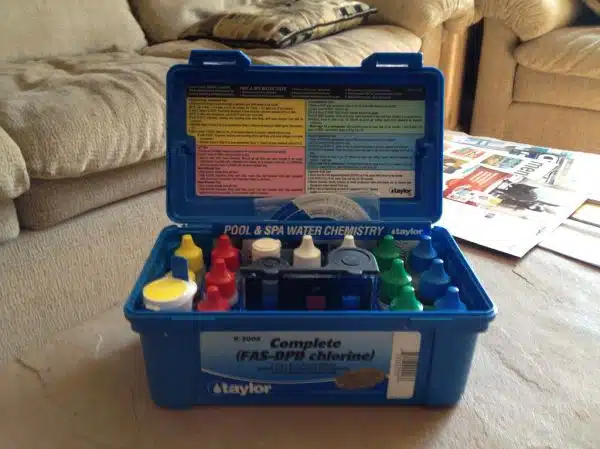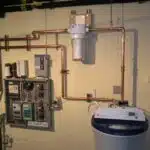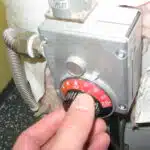As a certified pool technician, I have seen the detrimental effects of poor water quality on both the health of swimmers and the longevity of pool equipment. Maintaining proper water chemistry is crucial for a safe and enjoyable swimming experience. One of the most important tools in achieving this goal is a pool test kit. In this article, we will discuss how to properly use a pool test kit to check water quality.
A pool test kit allows you to measure various parameters including pH levels, chlorine or other sanitizer levels, total alkalinity, calcium hardness, and cyanuric acid levels. These measurements provide vital information about your pool’s water chemistry and help identify any imbalances that need correcting. By using a pool test kit regularly, you can adjust chemicals as needed to ensure that your pool is safe for swimmers and equipment. In the following sections, we will explain how to use each element of a pool test kit and interpret the results for optimal water quality maintenance.
Understanding The Importance Of Water Quality In Pools
Water quality is critical in maintaining a safe and healthy swimming pool environment. As a certified pool technician, I understand the importance of water circulation and the role of pool filters in maintaining water quality. Water circulation helps to prevent stagnant areas where algae and bacteria can thrive. The use of pool filters removes contaminants such as dirt, debris, and microorganisms that can pose a risk to swimmers’ health.
Effective water circulation is achieved when the pool water is properly filtered, treated with chemicals like chlorine or bromine, and balanced with pH levels. Pool filters come in different types such as sand, cartridge, and DE (diatomaceous earth) filters. These filters work by trapping debris on their surface or within the filter medium. Maintaining proper filtration is crucial not only for clean and clear water but also for prolonging the lifespan of your pool equipment.
In summary, understanding the importance of water quality in pools involves knowing how to maintain proper water circulation through effective filtration systems. As we move towards discussing how to use a pool test kit to check water quality, it should be noted that monitoring your pool’s chemical balance using these kits goes hand-in-hand with ensuring proper filtration for safe swimming experiences.
Types Of Pool Test Kits
When it comes to checking the quality of pool water, there are two types of test kits available in the market: digital and traditional. Digital pool test kits use technology to give accurate readings of pH, chlorine levels, and other chemical levels. On the other hand, traditional pool test kits require the user to mix chemicals with water samples and analyze the color changes to determine chemical levels.
Digital pool test kits have several advantages over traditional ones. They are faster and easier to use as they don’t require any mixing or analyzing colors; instead, they provide instant readings on a digital display. Additionally, digital pool test kits are more accurate than traditional ones as they eliminate human error in analyzing colors.
However, digital pool test kits also have their disadvantages. They are more expensive than traditional ones and require batteries for operation. Moreover, they may not be suitable for all types of pools as some models only work for specific chemical levels.
When choosing a pool test kit that suits your needs, consider factors such as budget, ease of use, accuracy level required, and compatibility with your specific type of pool. If you have a small home pool that doesn’t require frequent testing or if you’re on a tight budget, a traditional pool test kit may suffice. However, if you have a larger commercial or public pool that requires frequent testing or if you value accuracy over cost, investing in a digital pool test kit may be worth it.
Preparing The Pool And Test Kit For Use
Before starting any pool maintenance task, it is essential to clean all the equipment that you will use. This includes the test kit, which should be rinsed with clean water before and after each use. Cleaning equipment helps to prevent cross-contamination and ensures the accuracy of your test results.
Choosing the right test kit for your pool is crucial. There are several types of kits available, and each one has its unique features and benefits. For instance, some kits measure only chlorine levels, while others can detect multiple parameters such as pH, alkalinity, and calcium hardness. Consider the size of your pool and your specific testing needs when selecting a kit.
Once you have selected the appropriate test kit for your pool, it’s time to prepare it for use. Follow the manufacturer’s instructions carefully on how to fill each testing reagent bottle correctly. Also, ensure that you have a clean container to collect a water sample from your pool. A clear container makes it easier to see if there are any visible contaminants in your pool water.
- Clean all equipment before using
- Choose the right test kit based on your needs
- Follow manufacturer instructions carefully
- Use a clean container for collecting water samples
- Select a clear container for easy visibility
In preparation for testing pH levels in your pool water, there are several steps you must take first. Start by ensuring that all cleaning equipment is put away safely before taking a sample of your pool water into a clean container. Once you have collected enough water sample, follow the manufacturer’s instructions to add reagents into each bottle as directed carefully. Finally, shake or stir each bottle as instructed by the manufacturer before comparing color changes with those on the provided chart that comes with your test kit.
Testing Ph Levels
To ensure proper water balance, it is important to test pH levels regularly. pH measures the acidity or alkalinity of the water and should be maintained between 7.2 and 7.8 for optimal swimmer comfort and equipment longevity. To begin testing pH levels, first ensure that the test kit is calibrated correctly.
To calibrate a pool test kit, fill a small container with distilled water and add a few drops of the calibration solution until the desired level is reached. The calibration solution should correspond to the range of your test kit. Dip the pH test strip or reagent into the solution and compare the color to the chart provided by your manufacturer. Adjust accordingly if necessary.
If troubleshooting pH testing, there are several factors to consider. If readings are consistently too high or too low, check for any chemical imbalances in other areas such as total alkalinity or calcium hardness. Additionally, sunlight can affect pH levels throughout the day so be sure to take measurements at consistent times.
Next up: Testing chlorine or other sanitizer levels for safe swimming conditions.
Testing Chlorine Or Other Sanitizer Levels
Sanitization is one of the most important aspects of maintaining a healthy pool environment. It helps prevent the growth and spread of harmful bacteria, viruses, and algae that can cause illness or skin irritation. Testing sanitizer levels regularly is crucial to ensure that your pool is properly sanitized.
The frequency of testing levels depends on how often your pool gets used and the weather conditions in your area. As a general rule, you should test sanitizer levels at least once a week during the swimming season and every two weeks during the off-season. However, if you notice any changes in water clarity, odor, or appearance, you should test immediately.
To test chlorine or other sanitizer levels using a pool test kit, follow these steps:
- Dip the test strip into the water for a few seconds.
- Remove the strip from the water and wait for it to change color.
- Compare the color of the strip to the chart provided with your test kit.
- If the color matches within an acceptable range, then your sanitizer level is adequate.
- If not, adjust accordingly by adding more sanitizer or shocking your pool.
By regularly testing sanitizer levels in your pool using a pool test kit, you can ensure that your family and friends stay safe while enjoying their swim. In addition to sanitization testing, it’s also important to monitor total alkalinity levels in order to maintain proper pH balance. This will be discussed further in our next section on testing total alkalinity.
Testing Total Alkalinity
Maintaining the proper alkalinity level in a pool is essential for ensuring its water quality. Alkalinity refers to the ability of pool water to resist changes in pH, which is crucial because fluctuations in pH levels can cause discomfort and irritation for swimmers. The recommended range for total alkalinity is between 80-120 ppm (parts per million).
Balancing alkalinity levels involves adding either an acid or base to the pool, depending on whether the levels are too high or too low. If the alkalinity is too high, it can lead to cloudy water and scaling on surfaces. On the other hand, if it’s too low, it can cause corrosion of metal equipment and damage to plaster surfaces. To determine the current alkalinity level, use a pool test kit that includes a test for total alkalinity.
The importance of maintaining proper alkalinity levels cannot be overstated as it directly affects both swimmer comfort and overall pool maintenance costs. In addition to causing physical discomfort for swimmers, unbalanced alkalinity can also impact the effectiveness of sanitation chemicals such as chlorine. If pH levels fluctuate too much due to improper alkalinity levels, chlorine may become less effective at killing harmful bacteria and algae. Therefore, testing and balancing total alkalinity should be an integral part of any pool maintenance routine.
Transition into subsequent section: Now that we understand how important it is to balance our pools’ alkaline levels let’s move on to testing calcium hardness.
Testing Calcium Hardness
Calcium hardness is another important parameter that must be tested when checking the quality of pool water. Calcium in the water can cause buildup over time, leading to cloudy or scaling water. This buildup can also damage equipment and surfaces if not managed properly. On the other hand, low calcium hardness levels can make the water aggressive, causing it to corrode metal fixtures and plaster finishes.
To test for calcium hardness, a pool test kit comes with a specific reagent that reacts with calcium ions in the water. The test involves filling a sample chamber with pool water up to a marked line and adding drops of the reagent until the color changes. The number of drops needed to change color corresponds to a certain level of calcium hardness, which can be determined by comparing it against a chart provided by the manufacturer.
If your pool has high calcium levels, you may need to use water softeners designed for pools. These products work by removing excess minerals from the water and preventing them from building up over time. However, using too much can result in low levels of calcium hardness, which can be just as problematic as high levels. As such, it is important to monitor calcium hardness regularly and adjust accordingly to keep your pool in optimal condition.
Maintaining proper calcium hardness levels is essential for keeping your pool healthy and enjoyable for swimmers. Once you have tested for this parameter, it’s time to move on to testing cyanuric acid levels. This parameter measures how much stabilizer is present in the water, which helps protect chlorine from being degraded by sunlight. Let’s take a look at how this test is done in the next section.
Testing Cyanuric Acid Levels
Measuring accuracy is essential when testing for cyanuric acid levels in pool water. It is important to use a test kit that has been calibrated and stored correctly to ensure accurate results. Always check the expiration date on the test kit before use as expired reagents can affect the accuracy of the test results.
Troubleshooting issues may arise when testing for cyanuric acid levels, particularly if the results are outside of the recommended range. If the levels are too high, it can lead to chlorine lock, making it difficult for chlorine to effectively sanitize the pool water. On the other hand, if the levels are too low, there may not be enough cyanuric acid present to protect chlorine from being quickly degraded by sunlight.
It is important to note that cyanuric acid levels should be checked regularly to ensure pool water is safe and properly balanced. Inconsistent testing or failure to regularly check cyanuric acid levels can result in imbalanced pool chemistry which can cause damage to pool equipment or harm swimmers. In the next section, we will discuss how to interpret test results accurately and what actions should be taken based on those readings.
Interpreting Test Results
Testing pH levels is an important aspect of water balance to ensure it is within the proper range of 7.2 to 7.8. Chlorine levels should be tested regularly to ensure proper sanitization of the pool. A pool test kit should be used to measure the pH and chlorine levels in the pool water to determine if adjustments need to be made. A certified pool technician should be consulted if the test kit results are outside the recommended ranges.
Testing Ph Levels
Maintaining the pH levels of your pool water is essential for a healthy swimming environment. Measuring alkalinity and balancing pH levels are two crucial steps in ensuring that your pool water is safe to swim in. To test the pH level, use a pool test kit with color-coded strips and follow the instructions carefully.
Firstly, dip the test strip into the water and hold it there for a few seconds until it changes color. Then compare the colors on the strip to the chart provided in the kit to determine the pH level of your pool water. If the pH level is too low, add an alkalinity increaser such as sodium bicarbonate or baking soda. On the other hand, if it’s too high, use an alkalinity reducer like muriatic acid or sodium bisulfate.
It’s important to note that regularly testing your pool water’s pH level can prevent potential problems such as corrosion of metal parts, eye irritation, and skin rashes. Thus, measuring alkalinity and balancing pH levels are critical steps towards maintaining optimal conditions for swimming in your pool all summer long.
Determining Chlorine Levels
As a certified pool technician, ensuring that your pool water is safe and healthy for swimming requires measuring accuracy when it comes to determining the chlorine levels. Chlorine is an essential chemical used to sanitize your pool water and keep it free from harmful bacteria. However, too much or too little of it can cause problems such as skin irritation, cloudy water, or even algae growth. Hence, interpreting test results for chlorine levels is crucial in maintaining a balanced and safe swimming environment.
To determine the chlorine levels in your pool water accurately, use a pool test kit with color-coded strips similar to testing pH levels. Dip the strip into the water and hold it there for several seconds until it changes color. Compare the colors on the strip to the chart provided in the kit to determine the chlorine level of your pool water. The ideal range of chlorine levels should be between 1-3 parts per million (ppm). If you find that your chlorine levels are too low, add granulated shock treatments or liquid chlorinators. If they are too high, reduce them by diluting with fresh water or turning off your chlorinator.
In case you encounter any issues while troubleshooting problems with your chlorine levels, don’t hesitate to consult with a professional pool technician. They can provide expert advice and recommend solutions that best suit your specific needs. Remember that maintaining proper sanitation in your pool is critical not only for its longevity but also for safeguarding everyone’s health who uses it. Therefore, make sure always to interpret test results accurately and take necessary actions accordingly.
Correcting Ph Imbalances
After interpreting the test results of your pool water, it’s time to address any imbalances found. Did you know that pH imbalances are one of the most common issues in pool water? In fact, a study conducted by the CDC found that over 50% of public pools had improper pH levels. Not only can this cause discomfort for swimmers, but it can also lead to equipment damage and decreased effectiveness of sanitizers.
To correct pH imbalances in your pool water, there are several techniques available to you as a certified pool technician. Here are some common methods:
- Acid Adjustment: Adding an acid such as muriatic acid or sodium bisulfate will lower the pH level.
- Alkali Adjustment: Adding an alkali such as sodium carbonate or sodium bicarbonate will raise the pH level.
- Aeration: Running fountains or jets to increase oxygen levels in the water can help bring up pH levels naturally.
- Use of a Chemical Product: There are many products available on the market specifically designed to adjust pH levels.
- Monitoring: Regularly testing your pool water and adjusting as necessary is key to maintaining proper pH balance.
Remember that too much chlorine or other sanitizers can also contribute to pH imbalances. In the next section, we’ll discuss how to adjust chlorine or other sanitizer levels in your pool water.
Adjusting Chlorine Or Other Sanitizer Levels
To ensure that your pool water is safe and healthy for swimming, it is crucial to maintain proper sanitizer levels. Chlorine or other sanitizers can be added to the pool to keep bacteria and algae at bay. However, if the levels are too low, the water may become contaminated, while levels that are too high can cause skin irritation and other health issues.
To adjust chlorine or sanitizer levels in your pool, start by testing the pH level of the water using a pool test kit. If the pH level is off, it can affect how effective the sanitizer is at killing bacteria. Adjusting pH levels involves adding chemicals such as sodium carbonate or muriatic acid to raise or lower the pH accordingly.
If you need to increase sanitizer levels quickly, shocking the pool water might be necessary. This process involves adding a large dose of chlorine or another sanitizer to kill any bacteria present in the water. Shocking should only be done after testing and adjusting pH levels as necessary. It’s important to note that shock treatments can temporarily cloud the water or cause an odor, but this will dissipate after a short period of time.
To maintain a safe and healthy swimming environment, it’s crucial to regularly test and adjust chlorine or other sanitizer levels in your pool. In addition to testing for pH and shock-treating as needed, balancing total alkalinity is another essential step in ensuring optimal water quality. This involves adjusting alkaline substances such as bicarbonate and carbonate ions to prevent fluctuations in pH levels.
Balancing Total Alkalinity
Maintaining a balanced total alkalinity in your pool water is crucial to keeping it clean, clear, and safe for swimming. Total alkalinity (TA) measures the amount of alkaline substances in the water and affects the pH level of your pool. High TA levels can cause scaling on pool surfaces while low TA levels can lead to corrosion of metal components. Therefore, it’s important to keep TA within the recommended range of 80-120 ppm.
Balancing pH levels is essential in maintaining a healthy pool environment. When pH levels are too high or too low, chlorine loses its effectiveness at sanitizing the water. High pH levels can also cause skin irritation and cloudy water, while low pH levels can damage pool equipment and cause eye irritation. A balanced pH level should fall between 7.2 and 7.8.
To balance total alkalinity, you can add chemicals such as sodium bicarbonate or sodium carbonate to raise TA levels or muriatic acid to lower them. It’s important to test your pool water regularly using a reliable test kit and adjust chemical additions accordingly to maintain an optimal balance of chemicals in your pool water. By maintaining proper chemical balance, you’ll ensure that your pool remains crystal clear and safe for swimming enjoyment.
Maintaining proper total alkalinity is just one step towards creating a perfectly balanced pool environment; addressing calcium hardness issues is another critical element in ensuring optimal water quality for swimmers’ enjoyment.
Addressing Calcium Hardness Issues
Imagine a beautiful garden with lush greenery and vibrant flowers. The garden represents your pool, and the plants represent the various components that make up the water. Just as plants require certain nutrients to thrive, your pool requires specific levels of calcium hardness to stay healthy. Calcium hardness is a measure of how much dissolved calcium is in the water. Too little can cause corrosion, while too much can lead to scaling and cloudy water.
Prevention is key when it comes to managing calcium hardness levels. Regularly testing the water with a pool test kit can help identify any imbalances before they become problematic. If you live in an area with hard water, consider using a pre-filter on your hose when filling up the pool to prevent excess minerals from entering the water. Additionally, using a sequestering agent can help keep calcium and other minerals suspended in the water instead of forming scale on surfaces.
Dealing with high calcium levels may require draining some of the pool water and replacing it with fresh water that has lower levels of calcium. It’s important to consult with a professional who can accurately determine how much water needs to be replaced based on current levels and pool size. In extreme cases, adding specialized chemicals like sodium hexametaphosphate may be necessary to break down existing scale buildup. Proper prevention and maintenance will ensure that your pool stays healthy and enjoyable for years to come.
To maintain optimal pool chemistry, it’s also essential to regulate cyanuric acid levels.
Regulating Cyanuric Acid Levels
As a certified pool technician, it is important to understand the significance of regulating cyanuric acid levels in pool water. Cyanuric acid, also known as stabilizer or conditioner, is added to pool water to protect chlorine from being broken down by the sun’s ultraviolet rays. It helps maintain an adequate level of free available chlorine in the pool. However, high levels of cyanuric acid can lead to potential harm for swimmers and negatively affect water quality.
The importance of regulation lies in the fact that too much cyanuric acid can lower the effectiveness of chlorine and create a breeding ground for harmful bacteria and algae. This can increase the risk of skin irritation, eye irritation, respiratory problems, and even lead to gastrointestinal illnesses. Additionally, high levels of cyanuric acid can cause cloudy water and decrease overall water clarity. Thus, it is necessary to monitor and regulate cyanuric acid levels regularly.
Potential harm of high levels includes not only health risks but also financial costs associated with remedying these issues. In extreme cases where cyanuric acid levels are excessively high, draining and refilling the pool may be necessary. This can be a time-consuming process and result in additional expenses for homeowners or businesses with pools. Therefore, maintaining proper cyanuric acid levels is crucial for safe swimming and cost-effective pool maintenance.
Transition: Now that we have discussed the importance of regulating cyanuric acid levels in pool water, let us move on to explore various methods for maintaining optimal water quality for safe swimming.
Maintaining Optimal Water Quality For Safe Swimming
The pool is a symbol of recreation and relaxation. It can evoke feelings of joy, comfort, and escape from the stresses of daily life. However, maintaining optimal water quality is crucial to ensuring the safety of swimmers. As a certified pool technician, it is my responsibility to educate pool owners on understanding chemical imbalances and preventing waterborne illnesses.
Chemical imbalances in pool water can be caused by various factors such as heavy usage, weather changes, and poor maintenance. Understanding these imbalances is important because they can lead to skin irritation, eye redness, and even respiratory issues. Regular testing with a reliable pool test kit is necessary to avoid these problems. pH levels should be maintained between 7.2-7.8 while chlorine levels should be kept between 1-3 ppm (parts per million).
Preventing waterborne illnesses should always be a top priority for pool owners. Bacteria such as E.coli and Giardia can cause serious health risks if not properly treated or prevented. Proper filtration systems should be in place along with regular cleaning routines to keep the pool free from bacteria buildup. Additionally, swimmers should always shower before entering the pool and avoid swallowing any water while swimming.
Maintaining optimal water quality for safe swimming requires attention to detail and dedication from both pool technicians and owners alike. By understanding chemical imbalances and preventing waterborne illnesses through regular testing, filtration systems, cleaning routines, and proper hygiene practices; we can ensure that our pools remain symbols of recreation without compromising on safety.
Conclusion
It is crucial for pool owners to understand the significance of maintaining water quality in their swimming pools. Not only does it provide safe swimming conditions, but also helps preserve the longevity of your pool equipment and surfaces. By selecting the appropriate test kit and following proper testing procedures, one can ensure that their pool water is at its optimal level.
There are various types of pool test kits available in the market, each serving a specific purpose. Whether you opt for a digital or manual kit, it is essential to prepare your pool and kit before use. Testing pH levels, chlorine or other sanitizer levels, total alkalinity, calcium hardness and cyanuric acid levels are all imperative to maintaining optimal water quality. Just like how a skilled chef follows a recipe with precision to create a delicious meal, so too must we follow proper testing procedures to achieve the perfect balance in our pools.
As certified pool technicians, we take pride in ensuring that our clients’ pools remain clean and safe for their enjoyment. We stress the importance of using high-quality test kits and following proper procedures during testing as well as maintaining water chemistry balance through regular maintenance. By doing so, not only do you protect your investment but also provide a safe haven for all swimmers who dip into your crystal-clear waters. Remember that taking care of your pool’s water quality is an ongoing responsibility – just like tending to a garden – which requires dedicated attention and effort.
Image Credits
- “Pool Test Kit” by sdobie (featured)





























